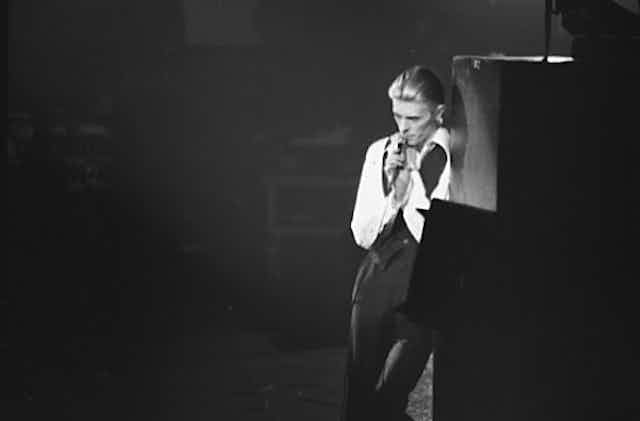Before he died in January 2016, David Bowie was universally regarded as one of the seminal rock stars of the modern age. He sold millions of records, won countless awards, and influenced numberless followers.
Almost without fail, tributes after his death lauded Bowie as a pioneer, particularly when it came to questioning ideas about gender and identity. But although Bowie’s willingness to challenge norms and boldness in doing so are undeniable, his position as a pioneer is more questionable.
Bowie is, in fact, directly linked to the Romantics, the writers and intellectuals who challenged similar norms some 200 years ago. And this link reveals not only the weight of Bowie’s work, but also the continuing influence of Romantic thought today.
My favourite version of David Bowie is the Thin White Duke of 1975 and 1976. As skinny as a thread and with a laser-cut profile, the Duke wore his snowy shirt and black waistcoat with an icy hauteur that inspired both my fascination and my envy.
But it wasn’t until recently that I realised that the Thin White Duke has roots that go deeper than David Bowie’s fascination with cocaine and kabbalah (his 1976 album Station to Station makes direct use of kabbalistic words and concepts). He is also a direct descendant of English Romanticism’s most alluring poet, Lord Byron.
Like Byron, Bowie lived and worked in a time of enormous social and intellectual upheaval. And also like Byron, he embraced that upheaval eagerly, becoming its best-known symbol.
Byron travelled to then-mysterious lands in the early 1800s, bringing back stories of exotic scenes and events. He wove this strangeness into tales whose fictional heroes – boldly and successfully defying moral and social expectations, embracing personal morality and liberty – seemed based on himself. Childe Harold, The Giaour, The Corsair were all poems whose eponymous heroes were taken as versions of Byron himself.
Bowie picked up on precisely these elements of Byronism when he adopted the persona of Ziggy Stardust, alien liberator and 1970s counterculture personified, but who shared the physical characteristics of David Bowie.
Bowie’s connection to Byron runs deeper still. Both explored the question of identity in their works, while in their real lives suggesting that identity might be nothing more than a surface. They happily created themselves as brands, delighting in making fans puzzle over what was real and what was not, who was singing or speaking.
For this, both men earned accusations that their work was shallow. In fact, such frankness confronts the very deepest questions about how to define identity. Do people have a single “self”? What even is self, really? What if identity is really just a series of masks, donned at the appropriate moments?
The more I considered Bowie, the more I realised that he wasn’t linked just to Byron. Bowie is a prime example of how all of Romanticism continues to influence our culture.

Bowie’s cross-dressing and his announcement that he was “gay, and I always have been” were brave statements in England in the early 1970s. (The parents of Bowie’s guitarist Mick Ronson were publicly harassed simply because of their son’s association.)
But 150 years earlier, John Keats confused the gender boundaries of his time, and had his work dismissed with contempt and his career destroyed because critics thought his poetry was effeminate. Bowie tapped into the same fear that Keats embodied, and his gender questioning links to concerns that lurk in the corners of many Romantic books and poems.
Ch-Ch-Ch-Changes
What’s more, while Bowie can be seen as rock ’n’ roll’s master of apocalypse and dystopia (his Diamond Dogs album opens with an image of a world full of “fleas the size of rats sucking on rats the size of cats” and doesn’t get much more positive from there), that vision can trace its roots back to William Blake’s highly symbolic and post-apocalyptic poetic visions, detailed in works such as Jerusalem and The Four Zoas.

In fact, a great deal of Bowie’s work links back to the genre of so-called “last-man narratives”, which envisioned the end of the world through the eyes of a last survivor and were very popular in the Romantic period. The songs “Space Oddity” and “Ashes to Ashes”, for instance, are the spiritual children of Mary Shelley’s The Last Man and Percy Shelley’s Alastor. These connections to Romanticism show that Bowie’s work can’t be dismissed as “just” pop music.
Furthermore, Bowie’s work shows that Romanticism still has an influence on the contemporary world. The Romantic Era, that grand and distant epoch, is not remote history, but a continuing influence on how we understand our own world. Bowie demonstrates that in some cases we are still Romantics, wrestling with the same questions that writers and thinkers grappled with more than a century ago: Who am I? How many “selves” do I have? Am I sure if I’m a boy or a girl? What will become of my world, of the world?
In an intellectual game of Chinese Whispers, these same Romantic questions and concerns appear in Bowie’s songs, and sometimes in our own minds, just in different words. In this way, it turns out, the Thin White Duke’s slender thread ties the present to the past, knots Bowie to Romanticism, and shows that Romanticism is knitted into our contemporary selves.

